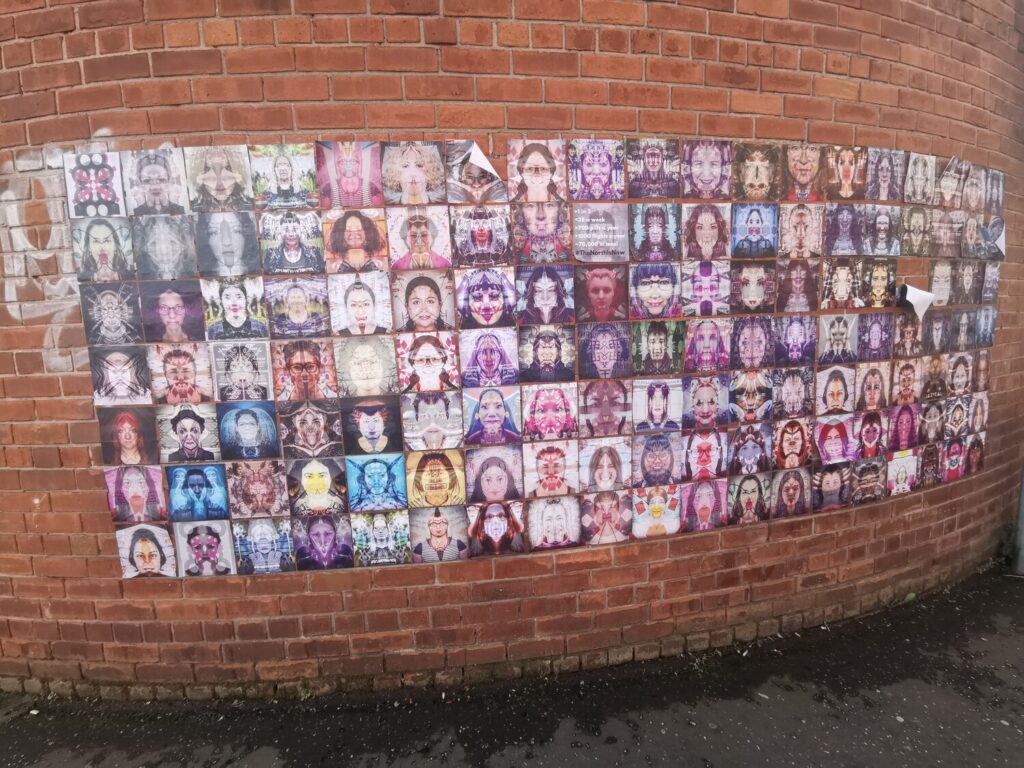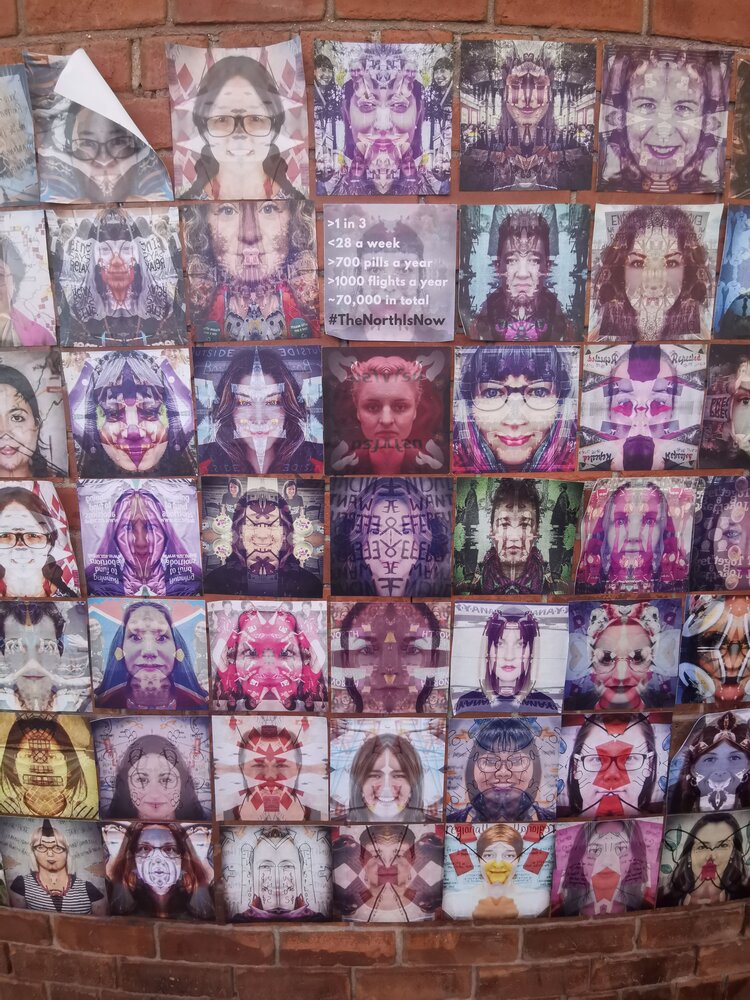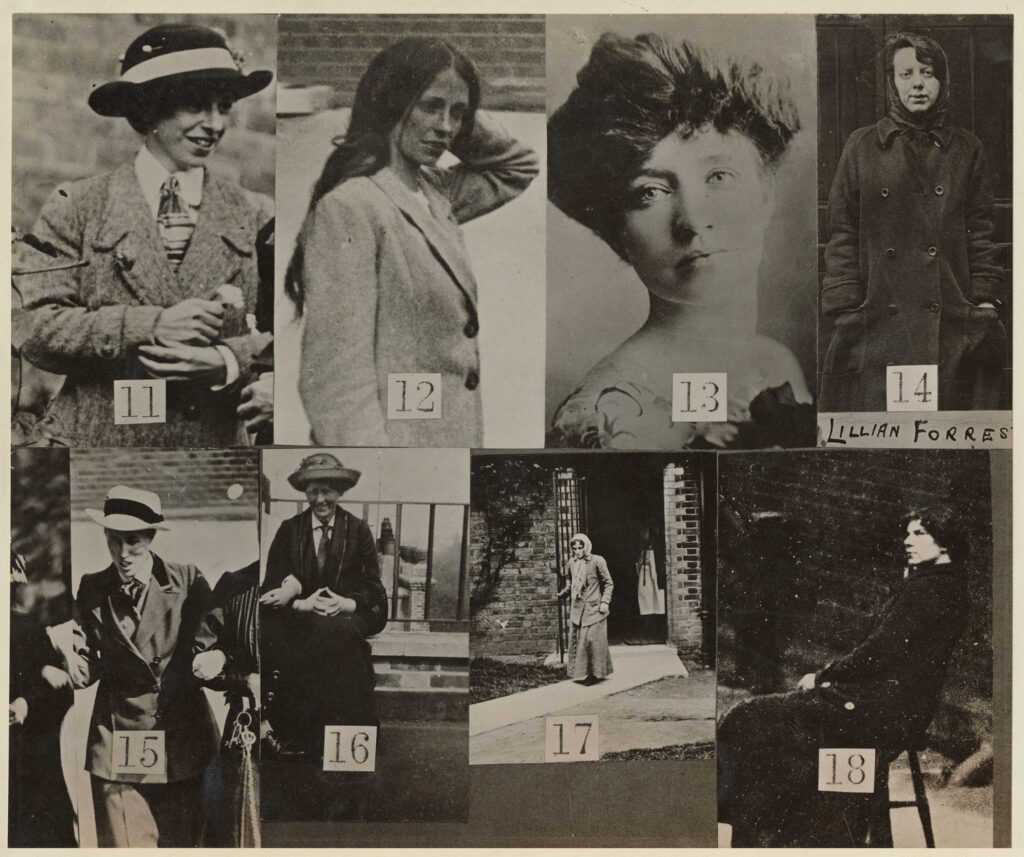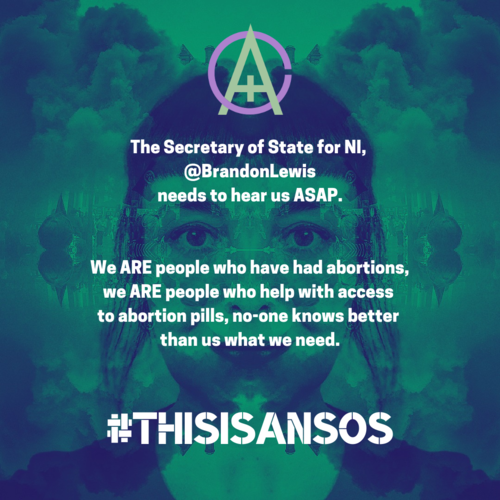Abortion Now, Abortion Forever
On the morning of October 22, 2019, the people of Northern Ireland woke up to the legally enshrined guarantee that the act of seeking an abortion would no longer be criminalised. In the streets of Belfast, within a handful of city thoroughfares, early commuters noticed brightly coloured rows of photographic print-images pasted onto buildings at eyeline level. On one corner, within Belfast's Cathedral Quarter, over a hundred prints were neatly arranged in rectangular formation, creating a mosaical spread of figures overlaid with vibrant, holographic-like patterns in blues, pinks, greens and yellows (Fig. 1). The work, titled An Appropriate Hobby by the artist Emma Campbell, had been stealthily affixed to the city streets the night before by Campbell and friends, including members of the art collective Array, of which Campbell is a member, and the campaign group Alliance for Choice. Working under the cover of the dark autumn night, these artists and activists were determined to mark Belfast's public sphere on the occasion of decriminalisation — a hard-fought achievement that followed decades of campaigning against an historic system of reproductive oppression.
This essay considers An Appropriate Hobby as a work of socially engaged art that renders visible the labor of activists and organisers in the movement to decriminalise abortion in Northern Ireland (NI). An Appropriate Hobby presents jubilant visualisations of activist labor that re-narrativize the function of photography in struggles for reproductive justice. In foregrounding portraits of activists, including artist-activists, central to the struggle for decriminalisation, Campbell draws attention to labor practices that have been economically devalued and broadly ignored politically.
An Appropriate Hobby therefore accords with Leigh Claire La Berge's assertion that socially engaged art represents economic and affective inequality with specific attention towards some form of restitution or recognition.1 Campbell's artwork, produced and disseminated collaboratively, opposes the marginalisation of feminist collective action and its labor forms. More specifically, it renders the victories of abortion rights activists in NI less assimilable into an homogenized narrative of progressive state liberalism. In doing so Campbell recasts technologies of state surveillance as artistic media by drawing subversively on the cultural afterlives of prison portraiture.



Campbell's artwork brings recognition to abortion rights activists and preemptively counters a move by the political class in NI to appropriate the achievements of groups like Alliance for Choice and Alliance for Choice Derry for election purposes.2 Mainstream party politicians' appropriation of grassroots activism in the aftermath of the successful Repeal movement in the Republic of Ireland has been widely criticised, and it signifies the continued rhetorical seizure of activist labor, in all of its variations, by liberal parliamentary politicians on the island of Ireland.3
In labelling An Appropriate Hobby as socially engaged art, I follow Campbell, who cites the work of scholars and activist-artists like Lucy Lippard, Pablo Helguera and Grant Kester.4 My reading of Campbell's work here further emphasises the material stakes of An Appropriate Hobby, drawing on the critical theory of La Berge to explore the imbrication of (non-)waged work, art work, and reproductive justice activism towards a way to think the solidaristic potential of art within a new internationalism.
An Appropriate 'Hobby'
In 1861 Westminster introduced the Offences Against the Person Act, which punished 'unlawful procurement of miscarriage' with life imprisonment.5 1n 1967 the Abortion Act was passed, creating a statutory framework for the provision of legal abortion in England, Wales, and Scotland. The 1967 Abortion Act did not extend to Northern Ireland due to a then-standard practice of excluding NI from legislation on matters of sexual morality.6 A fear of provoking 'religious and political controversy of a most undesirable kind' provided a judicial excuse for legislators in Westminster to remain detached from NI affairs and the deepening problems of sectarianism.7 Thus began decades of political reluctance to reform Northern Ireland's Victorian-era legislation on abortion — an effective abandonment of women and pregnant persons in the region to an archaic system of bodily control and coercion.
1861, as Campbell notes on her website, was also the year of the first colour photograph in the UK, taken by James Clerk Maxwell in his home laboratory in London.8 The photograph emerged from Maxwell's research into colour imaging, and investigates the capture of colour from new combinations of film emulsion and chemical filters. The resulting blurred image of a small tartan ribbon is insect-like in its delicacy; the patterning of colour, light and shade are resonant of a butterfly wing under a magnifying lens (Fig. 2). Maxwell's colour photograph heralded a major advancement in the field of photography, although Maxwell himself was reportedly more interested in qualities of light and human vision than photographic mechanisms.9 His sudden success in 1861 has become symbolic of the rapid advancement in new forms of empirical investigation and applied science during the Victorian period. The allusionary qualities of 'Tartan Ribbon' also mark the interplay of natural history illustrations, new arrangements, or categorisations, of specimens, and Victorian artistic practices. The ability to capture and photographically 'fix' reality accelerated alongside a belief in the mastery of organic forms and 'the elevation of "objectivity" into an essential scientific moral quality.'10
The coincidence of the first colour photograph and the Offences Against the Person Act in 1861 form the historical backdrop to An Appropriate Hobby. Each rectangular, passport-like image in the project centres a portrait of an individual who has been active within the movement towards reproductive justice. Symmetrical patterns overlay the face of the subject, recalling the geometrical designs of a kaleidoscope, the intricate detail of butterfly wings, and the reflective hues of Maxwell's 'Tartan Ribbon.' Detail within the background of the symmetrical overlay signifies the specificity of the subject's contribution to the struggle for reproductive justice: one 'passport butterfly portrait' includes a glimpse of a Ryanair flight awaiting take-off, a routine element in the abortion-seeking, transnational journeys between Ireland and the UK that have operated, North and South, for generations. Another portrait includes an instance of exultant protest, another a moment from a pedagogical project, another a glimpse of a Speakout, or peer-sharing group, for those who have had abortions.

Each of what Campbell has described as the 'passport butterfly portraits' that constitute An Appropriate Hobby thereby entwines the individual contribution of portrait subjects with the collective effort required to propel the movement for abortion decriminalisation. Mobile scenes of the historic and situated labor behind decriminalisation generated by An Appropriate Hobby became available for transfer to different institutional and extra-institutional settings (such as the city walls) within NI. In the days prior to decriminalisation, Campbell describes how she adjusted the installation in a local gallery so that it appeared as if the photographs were tumbling outside of the installation frame, exceeding the space allocated to the artwork and to the activist movement. The effect was to demonstrate the ongoing breakdown of ordered regimes of reproductive control that had been heretofore carefully cultivated in Northern Ireland.11

An Appropriate Hobby relied on the voluntary involvement of potential or past abortion seekers engaged in the movement for reproductive justice — participation facilitated by Campbell's dual presence within the movement as artist and documentary photographer, and as co-convenor of Alliance for Choice. In this respect, the work epitomizes relational aesthetics as Nicholas Bourriaud defines the term; it incorporates 'methods of social exchange, interactivity with the viewer within the aesthetic experience being offered to him/her, and . . . various communication processes.'12 Socially engaged artwork of this kind is distinguished by a 'substrate of intersubjectivity', which implies not only the social setting of the reception of the artwork, for example, Belfast's Cathedral Quarter on the morning of October 22nd, but equally the collaborative nature of the production of the artwork itself.13
In an essay for the volume, Decriminalizing Abortion in Northern Ireland, Campbell introduces An Appropriate Hobby with a consideration of the reciprocal nature of socially engaged art: '[I]n many ways the content of the work itself ought to offer something to the community it is working from within or on behalf of, as well as the spaces of participation that have acted as sites of empathetic engagement and transformative knowledge.' (63) Campbell acknowledges the participatory process of the artwork in political and affective terms here, focusing on the 'dialogical' and emancipatory emphases of Lippard and Kester's work. However, the question of the role and presentation of labor is also pertinent in two senses. Firstly, in the sense of the artwork's reliance on participants whom Campbell recruited to work with her as co-producers and disseminators. Secondly, in the sense of the assimilation of An Appropriate Hobby within a broader movement that labors to improve reproductive care and material conditions for NI communities. As La Berge observes in her reading of Bourriaud, the intersubjectivity of socially engaged art is both material and affective: its form derives from the content of the labor (activist and artistic) that produced it.14
La Berge's analysis of socially engaged art focuses critical attention on the decommodification of artistic labor and the incorporation of such decommodified labor into the production of and impetus for the art work, as we see in Campbell's case. La Berge uses the term 'decommodification' to express the inability of artists to access a wage or market compensation for their art work: their labor becomes decommodified and displaced from the market. The degradation of the wage is not exceptional to the art world, but the economic specificities of the art object offer space to reflect on the reconstruction of labor more generally.15 Moreover, La Berge finds the most interesting case studies for such analysis among contemporary works of socially engaged art. Socially engaged art by this definition represents and attempts to reckon with forms of social inequity, whether they are economic or affective. It creates an opening for critical contemplation, if only for a moment, that stages the relationship between waged work and art work. In this way, it extends a demand 'for social reorganisation, for economic equality . . . and for access to the power to transform social relations.'16 The gradual transformation of socially engaged art's agenda 'towards social function' and the restructuring of our systems of waged labor towards decommodification pressures any critical grasp of the aesthetic.17 The ideology of the aesthetic has been undone by the decommodification of labor, La Berge asserts.
What, then, does it mean, to make an aesthetic claim about a work like An Appropriate Hobby and its 'social function'? For La Berge, decommodified labor governs the aesthetic of socially engaged art by organizing the production of and reaction to artful stimuli.18 The conditions by which Campbell's work is produced and distributed — through participatory methods, volunteer work, artist-activist struggles for reproductive justice - appear alongside the artwork's thematic exposure of labor forms to mediate possible aesthetic judgements in reaction to it. Anticipating those judgements, An Appropriate Hobby provocatively explores the longue durée of feminist organising in dialogue with the labor of art-activism. It conjoins historical trajectories of feminist activist and artistic labor as separate yet interconnected modes of work that have been subject to delimitation, appropriation and decommodification. Unlike wage-based forms of labor that produce surplus value within the working day, and like artistic labor, activism has become professionalized over time while simultaneously operating disproportionately according to the acquisition of volunteers. '[O]nce radical organisations that had been part of a feminist movement that responded to reproductive oppressions [..] had slowly and incrementally been absorbed into the neoliberal state agenda,' writes Camilla Fitzsimons on the Repeal movement, 'where their core purpose was now individualised service delivery on a shoestring budget.'19
Confronting these conditions of labor, the reflexive elements of An Appropriate Hobby draw together histories of feminist activist work in the United Kingdom and Ireland and their state-capture through technologies of surveillance. They glance backwards to the watershed year of 1861 and the twinned instantiations of reproductive oppression and colour photography. Maxwell's 'Tartan Ribbon' appears here as a reflection of the natural form of the butterfly, pinned into place in the service of scientific observation, later liberated by feminist artists like Judy Chicago in the name of a progressive, emancipatory politics.20 'Tartan Ribbon' functions also as a signifier of Victorian-era technological advancement that would usher in new scopic regimes attendant to the reinforcement of social hegemony.
Indeed, An Appropriate Hobby draws a direct line between 'Tartan Ribbon' and the state surveillance of suffragettes decades later. Now considered to be the first instance of covert surveillance by the British state, London Metropolitan Police acquired photographs of English suffragettes for tracking purposes during a campaign of criminal damage in the early years of the twentieth century. Imprisoned suffragettes refused to pose compliantly for mugshots, causing the police to send in-house photographers from Scotland Yard to Holloway prison where they were instructed to take clandestine portraits of the resistant women from inside a van parked in the exercise yard. Photography hence became institutionalised as an invaluable tool for the persecution and oppression of 'terrorist' organisations — a signifier, to Campbell, of state attempts to capture and suppress feminist activism.
Much has been written about the English suffragettes' increasingly militant campaign of resistance during the early twentieth century, but little has been mentioned of these attempted mugshots, as the critic Linda Mulcahy suggests.21 Mulcahy describes how her own investigation of the histories of these images led her to the archives of the National Portrait Gallery in London, where portraits of Kitty Marion and Mary Raleigh Richardson were included in the gallery's collections (Fig. 4). She assumed the portraits had been acquired by gallery curators, but discovered later that the mugshots were sent to the National Portrait Gallery by the Criminal Record Office at Scotland Yard in 1914 as a means of defence against the threat posed by these 'fanatical' women.22 Since 1912, suffragettes had been deliberately damaging prominent artwork so as to draw attention to their campaign — most notably, perhaps, 'the slasher' Mary Richardson's attack on Velázquez's The Toilet of Venus with a meat chopper in March 1914.
Deliberate destruction of valuable, state-owned artworks, a controversial method of protest in Britain to this day, marked a tipping point for police treatment of suffragettes. These destructive acts united the collective labor of feminist activism with the decommodification of the art object via its obliteration. The artwork was retooled as a mechanism within the movement for womens' suffrage, it became 'de-autonomized', to use Shannon Jackson's term — 'an artful gesture . . . that subtly challenges the lines that would demarcate where an art object ends and where the world begins.'23
In her reappraisal of these archived suffragette mugshots, Mulcahy attends to the institutional obliteration of histories of feminist protest movements while demonstrating the failure of the state to achieve control of its wayward subjects — "They have forced the camera to act as the handmaiden of their campaign rather than an oppressive medium of their political destruction."24 Similarly, Campbell presents the portraits of An Appropriate Hobby as defiant representations of collective action that counter the lack of official records of feminist activism in Ireland. Her collaborators are mutinous in their refusal to concede praise and renege on their public role in the achievement of decriminalisation in Northern Ireland.

Gallery, London.
In the aftermath of its completion, participants in An Appropriate Hobby began, unprompted, to use their passport butterfly portraits as social media avatars. This was perhaps unsurprising given that the formal limitations and attendant filters of Instagram were component elements in Campbell's imagining of the passport butterflies — a deliberate nod to the creeping influence of the world of digital activism as well as an engagement with a new boundedness to photographic image-making. In this way, Campbell contends, An Appropriate Hobby reflects the world of digital activism more readily than other projects aligned with the decriminalisation movement.25
On social media applications, participants signal to each other a shared agenda and political inclination, uniting in a popular struggle for abortion access against a political narrative that encloses abortion as 'controversial,' 'sensitive,' and 'unwanted'. Equally, the transmogrified form of the passport portrait speaks to online play with self-creation and evasion. The face is there but not quite perceptible, so it dodges the violence of surveillance and ease of identification. Later still, portraits from An Appropriate Hobby became campaign tiles for post-decriminalisation organising in NI, attesting to the adaptability of the passport image and its potential resource-value as support for national and international reproductive justice movements (fig. 5).

It is important to see these avatars and campaign tiles as not simply representations of the collective but to grasp them in their fullness of detail as indices of the labor power behind the struggle for reproductive justice. Campbell's An Appropriate Hobby demonstrates the critical role of socially engaged art nationally and internationally as a signifier of digital activist communities and as a campaign tool in the continuing movements for abortion access and decriminalisation. The artwork's mobile representation of scenes of labour allows for easy reproduction and resonance with allied movements, fomenting solidaristic relationships within what Verónica Gago describes as the Feminist International in emergence today.26
Movements for the decriminalization of abortion care have been successful in countries including Northern Ireland, Mexico, South Africa, Thailand, and South Korea while partial decriminalisation has occurred in India and Nepal. There the struggle continues, alongside ongoing campaigns in Nigeria, Malawi, Poland, and the US, to name a few, as well as a recent renewal of attention to the criminal codification of abortion in England, Wales, and Scotland. The historical arc of An Appropriate Hobby, from 1861 to the present, is rooted in regional legislation but it is shadowed by the colonial expansion of this legislation within the British Empire, the legacy of which can be glimpsed in the list of countries above. To take an internationalist perspective is to perceive and build from these colonial linkages while forging, as Gago writes, a resonance and coordination between sites that mark differences and divergences.27 Campbell's work of labor and restitution has played a role in processes of abortion decriminalisation in NI, but it is only one example within a global profusion of cultural activism for reproductive justice.
Acknowledgments: With many thanks to Emma Campbell and her work as artist and activist; to Array, Alliance for Choice, Alliance for Choice Derry, and allied groups who continue to campaign for reproductive justice and equality in NI; to Chiara for reading over an early draft; and to the editors of this cluster for collating and guiding such a brilliant set of essays.
Emma Crowley is a Lecturer in English Literature at the University of Bristol where she specializes in teaching comparative and postcolonial literature and culture. She is developing a project exploring the intersection of writing, visual art and organised struggles for reproductive justice in Mexico and Northern Ireland, departing from the work of Cristina Rivera Garza, Sayak Valencia and Verónica Gago.
References
- Leigh Claire La Berge, Wages Against Artwork (Durham, NC: Duke University Press, 2019), 42.[⤒]
- See, for example, Sally Sheldon, Jane O'Neill, Clare Parker, Gayle Davis, "'Too Much, too Indigestible, too Fast'? The Decades of Struggle for Abortion Law Reform in Northern Ireland," The Modern Law Review, 83 (2020), 761-796. [⤒]
- Camilla Fitzsimons, Sinead Kennedy, Repealed: Ireland's Unfinished Fight for Reproductive Rights (London: Pluto Press 2021), 128-129; M. Barron, Learning from the Together for Yes Campaign, 2019, https://www.nwci.ie/learn/publication/learning_from_the_2018_together_for_yes_campaign; Anna Carnegie, Rachel Roth,"From the Grassroots to the Oireachtas: Abortion Law Reform in the Republic of Ireland", Health Human Rights, 21 (2019): 109-120.[⤒]
- Lucy Lippard, "Trojan horses: Activist Art and Power," in Waltz, R., Modernism (Harlow: Pearson Education, 1984); Grant Kester, Conversation Pieces: Community and Communication in Modern Art (Berkeley: University of California Press, 2013); Pablo Helguera, Education for Socially Engaged Art: Materials and Techniques Handbook (New York: Jorge Pinto Books, 2011). [⤒]
- Sheldon et al., "Too Much," 762; The reciprocity between colonial and domestic legislation within the British Empire has ensured that residual elements of the Offences Against the Person Act and other British colonial-era legislative practices, have remained influential in areas of the Britsh Empire far beyond Ireland. See, for example, the Human Rights Watch report: "This Alien Legacy: The Origins of 'Sodomy' Laws in British Colonialism," https://www.hrw.org/report/2008/12/17/alien-legacy/origins-sodomy-laws-british-colonialism.[⤒]
- Sheldon et al., "Too Much," 763. [⤒]
- Sheldon et al., "Too Much," 763.[⤒]
- Emma Campbell, personal website, https://www.emmacampbell.co.uk/an-appropriate-hobby.[⤒]
- Abigail Cain, "How the World's First Colour Photograph Came to Be", Artsy, https://www.artsy.net/article/artsy-editorial-worlds-first-color-photograph. [⤒]
- Nancy Rose Marshall, Victorian Science and Imagery: Representation and Knowledge in Nineteenth Century Visual Culture (Pittsburgh: University of Pittsburgh Press, 2021).[⤒]
- Emma Campbell, "Activism Outside the Academy", Reproductive Justice in a Post-Covid World: Transnational Protest and Resistance, University of Cambridge, April 19, 2023.[⤒]
- Nicholas Bourriaud, Relational Aesthetics, translated by Simon Pleasance, Fronza Woods, Mathieu Copeland (Dijon: Les presses du reels, 2002).[⤒]
- La Berge, Wages Against Artwork, 92.[⤒]
- La Berge, Wages Against Artwork, 94. [⤒]
- La Berge, Wages Against Artwork, 11. [⤒]
- La Berge, Wages Against Artwork, 17.[⤒]
- La Berge, Wages Against Artwork, 17.[⤒]
- La Berge, Wages Against Artwork, 10. [⤒]
- Fitzsimons, Kennedy, 92.[⤒]
- See, for example, Chicago's works The Great Ladies Transforming Themselves into Butterflies (1973), Flesh spreading her wings and preparing to fly (1974), The Dinner Party (1974 - 79). [⤒]
- Linda Mulcahy, "Docile Suffragettes? Resistance to Police Photography and the Possibility of Object-Subject Transformation," Feminist Legal Studies 23 (2015): 79-99 (81).[⤒]
- Mulcahy, "Docile Suffragettes?" 90. [⤒]
- Shannon Jackson, Social Works: Performing Art, Supporting Publics (New York: Routledge, 2011), p. 28. [⤒]
- Jackson, Social Works, 97. [⤒]
- Campbell, An Appropriate Hobby (2022), 64.[⤒]
- Verónica Gago, Feminist International: How to Change Everything, translated by Liz Mason-Deese (London: New York, 2020).[⤒]
- Gago, Feminist International, 196.[⤒]
